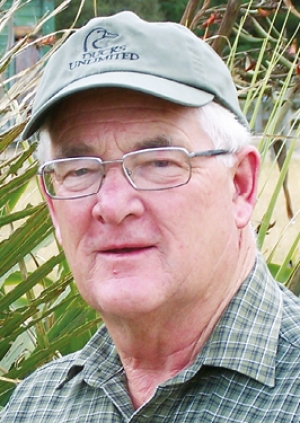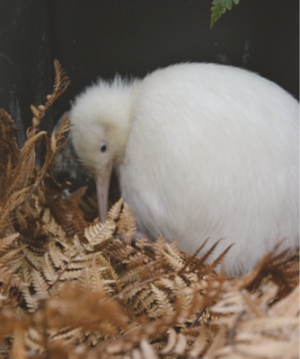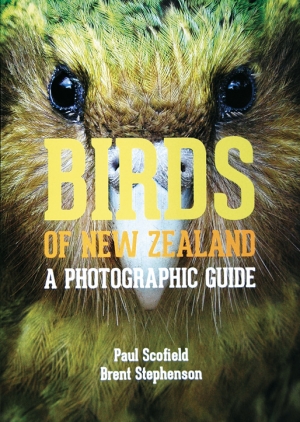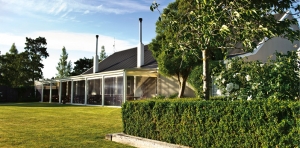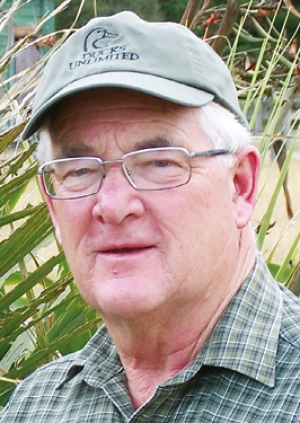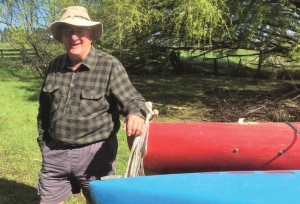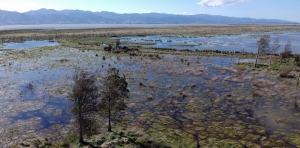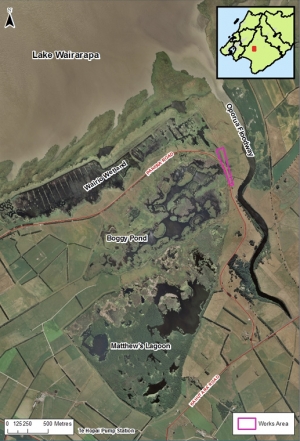Super User
Presidents Report AGM 2014
Wildlife is a great joy to all of us whether they are wetland, forest or common species.
Sitting writing this I am looking out my office window at the coming and goings of numerous wax eyes and the occasional tui feeding on the sugar water put out for them. I still get a thrill seeing these common species even though I have had the pleasure of working with some of our most endangered species like kakapo and kiwi. Wetlands, waterfowl and marsh birds are no different and this is what drives DU.
The last year has been a good one with our Flight magazine editor Liz Brook, Secretary Jan Abel, and Web Site and Quack Club Coordinator Michelle Cooper all making great contributions in promoting DU and ensuring we operate well on behalf of our members.
Their input is pivotal to what we achieve. To the other Directors thank you for your efforts.
Discussions are continuing with Tony Roxburgh Chairman of the National Wetland Trust as to how we can work together.
They have progressed designs for their national wetland centre to be located at Lake Serpentine near Te Awamutu.
Wairio Wetland near Lake Wairarapa continues to be our flagship project with the benefits of the Stage 4 project resulting in 35 hectares of shallow wetland (maximum depth 1.2 metres) being created by the construction of a 1.2 km bund. Waterfowl use is high and includes regular sightings of the endangered bittern. This work was funded by Greater Wellington Regional Council, NZ Game Bird Habitat Trust and DU. Planning for a similar sized project for Stage 2 and 3 is well advanced and should be constructed next summer. Tree planting and maintenance are also major tasks funded from a range of other sponsors. The AGM field trip takes in Wairio so you will be able to see and hear firsthand what has been happening.
We have been long term supporters of a number of very successful waterfowl projects (Pateke, Whio, White swan). A new focus has been on the endangered bittern (less than 1000 birds in NZ and 750 Australia) and the DU Board are currently considering a proposal to support a study by a doctorate student from Massey University. Bittern will be a great additional flagship species for DU’s wetland objectives.
DU’s slowly declining membership is still a concern and our members are aging. This will be a focus for the Board this year.
During the summer we lost one of our great stalwarts in the passing of Dave Johnson who was a life member. Dave has been a magnificent supporter and mentor for many of us. His contribution will be sorely missed.
I look forward to seeing as many as you as possible at the AGM at Martinborough. The organisers have a great programme planned.
John Cheyne
Happy Birthday Manukura
Three years ago staff at Pukaha Mount Bruce had a huge surprise when a kiwi egg hatched and out came a pure white kiwi!
Manukura is a very special white kiwi, and she turned 3 on May 3 this year.
A month of celebration activities was arranged. As well as a daily Manukura ‘fact hunt’ through the reserve there were a number of activities every weekend during that month.
Thanks to the Ten O Clock Cookie Bakery & Cafe in Masterton, there was a huge birthday cake in the kiwi house with a slice for every visitor.
Footnote: I called in to Pukaha Mount Bruce for a sneaky look at Manukura as she slowly walked around her enclosure in the kiwi house. Carefully she inserted her beak deep into the ground searching for worms and other tasty morsels. She is a big girl now and well worth a visit.
PS. The café at Pukaha has undergone a change and is now called Wild Café - new management but same staff –same delicious coffee and food.
Liz Brook
Manukura – a kiwi that flies
Wairarapa residents travelling around New Zealand and/or the world are being encouraged to take a Manukura soft toy with them. The idea is to take photos and send them back to the local newspaper. Of course you need to purchase a Manukura soft toy.
Check with Helen at Pukaha Mount Bruce [This email address is being protected from spambots. You need JavaScript enabled to view it.] and she will arrange to send you one.
If you are keen and have a Manukura toy with you, send your photos to This email address is being protected from spambots. You need JavaScript enabled to view it. The best photo will win a $1000 prize courtesy of a Masterton travel agency.
Bird book to win
Birds of New Zealand – A photographic guide put together by Paul Scofield and Brent Stephenson, published last year by Auckland University Press, it has information on 365 species of our birds.
I have been working my way through this amazingly interesting book. It is not the sort of book you just pick up and read from cover to cover. Reading is only part of it, there are so many wonderful photographs to examine and admire.
As one reviewer said, “It is an essential guide to the birds of New Zealand”. With more than 1000 colour photographs, and maps to pinpoint locations, the book covers species that occur naturally in the wild, those that have established wild populations and also rare visitors.
The introduction alone has a plethora of information, including tips on photographing birds and advice on learning to identify songs and calls.Taking pride of place as the first bird in the book are Kiwi – all five of them.
The introduction to each also gives the reader an indication of its current status. I.e. At risk, Critically endangered, Threatened, Endangered, Self introduced, Rare vagrant, Common migrant, Abundant naturalised introduction and so forth.
Jodi Salinsky of Southern Bird wrote “Overall, this book gets an A+. It is a “must have” extremely current resource for the naturalist, avian enthusiast, novice bird watcher and serious birder alike.”
Jim Mora, Radio NZ National said “Two fantastic talents involved – Brent Stephenson the photographer and Paul Scofield the natural historian. That’s a great collaboration.”
Available from all good booksellers, $59.99.
Flight has one of these books to give away to a lucky Ducks Unlimited member.
To go into the draw send me an email with Bird Book in the subject line. Include your address and phone number, or put your address and phone number on the back of an envelope and post it to me.
Email: This email address is being protected from spambots. You need JavaScript enabled to view it.
Post: Liz Brook, 766 Beaconsfield Valley Rd, RD9, Feilding 4779.
Deadline is August 15.
AGM venue – a right cracker
From the President
A range of DU projects are progressing well with the prospects for some new ones. Read more in my President’s Report for the AGM on Page 5.
Preparations for our 2014 AGM being held near Martinborough 2-3 August are well advanced with an interesting programme in terms of field trip and speakers. The venue at Brackenridge Country Retreat is great and I m sure you will enjoy yourself. It is still not too late to register. I look forward to catching up with everyone.
Unfortunately Dave Johnson a DUNZ Life Member passed away recently and a number of our members attended a celebration of his life beside the magnificent pond on his property at Reporoa. Dave was a great supporter of DU and Wetland care NZ and his wisdom will be missed.
John Cheyne
Trans-Tasman bittern knowledge exchange
Australian wildlife ecologist and bittern expert Matt Herring visited last year and took the time to catch up with his New Zealand counterparts.
“The best thing we can do for nature is simply spend more time in it. From there, reverence grows and action flows.” M Herring, 2013
What a wonderful trip. It was as if we spent a week compiling precious pieces of a rare, incomplete jigsaw puzzle called “Australasian Bittern Ecology and Conservation”.
After several years of being in touch via email and phone, it was so nice to finally get together with the New Zealand bittern crew and see some of their sites first hand.
There is some great work happening across the ditch and a strong sense of being united in working towards reversing the decline of this iconic waterbird that we share. It is affectionately known as matuku hūrepo in Māori, or matuku for short.
The knowledge exchange began with the biennial National Wetland Restoration Symposium in Napier where I was honoured to be a keynote speaker, focusing on the importance of community engagement, novel habitats and active management.
We then had a day visiting wetlands around Hawke’s Bay, including Pekapeka Swamp, followed by a successful bittern workshop day organised by Matt Brady from DOC. It was now crystal clear to me that there’s a lot of love for matuku in New Zealand.
With much discussion about wetland restoration targeting bitterns, it was astounding for many folk to learn about bitterns in rice and how bare, ploughed paddocks ready for sowing are able to support nesting bitterns less than three months later. There was a range of inspiring case studies from around New Zealand at the workshop, and we got to visit some local work in Hawke’s Bay with Hans Rook.
After that, it was time to begin a broader tour of bittern sites across the North Island. First stop was Lake Whatuma, and thanks to John Cheyne and Bernie Kelly, we were able to track some bitterns while kayaking.
We discussed key issues like willow control, raupo (cumbungi) harriers as bittern nest predators.
This wetland has up to nine booming males, but far fewer females, perhaps only three. The apparent shortage of female bitterns across New Zealand is something DOC’s Emma Williams is very concerned about. We may well have the same problem in Australia.
males in rice fields have up to three nesting females in a single territory, there is emerging evidence that would support a general shortage of females here too. It’s definitely something we should consider: a booming male may not be a sufficient indicator of breeding
or site quality.
It was now October and time to visit the 7200-hectare Whangamarino Wetland, between Auckland and Hamilton. This Ramsar site was once the world’s most important wetland for the Australasian bittern, with more than 140 booming males in 1980.
Nowadays, there’s only about a dozen. I learnt about the many issues that are implicated in the decline, such as introduced species and water quality, but I think the huge water level fluctuations are central.
Near Tauranga, we visited the Lower Kaituna Wetland, and were lucky enough to spot a bittern feeding in the eleocharis. Part of the restoration work in the broader area is starting from scratch, essentially constructing new wetlands.
And on the edge of Tauranga itself, right on the coast, we visited a bittern breeding site that was tidal. This was quite perplexing. The vegetation is low and we wondered where they build their nests without being flooded.
Unfledged chicks have been found in land nearby, including a recreational park. We talked about how this site would be suitable for a thermal drone in locating nests and monitoring breeding success.
All in all, a wonderful trip, with special thanks to all who made it possible. I’m looking forward to returning the favour!
The love for matuku in New Zealand is admirable, and the conservation work being done is inspiring
Bittern count reassessed
New research highlights the importance of New Zealand’s wetlands for one of our most secretive native birds, the Australasian bittern or matuku, Conservation Minister Eugenie Sage said on World Wetlands Day, 2 February.
GPS tracking of matuku/bittern has, for the first time, revealed that it flies more than 300km between wetlands in the eastern South Island as well as large distances between North Island wetland sites.
Previously it was thought bittern ranged only small distances from their home wetlands.
DU is one of several partners in the Department of Conservation-led research, which shows that bittern rely on a network of wetlands to feed and breed in.
It also means matuku/bittern may be rarer than previously thought as birds have probably been double-counted in local counts in different parts of the country.
In the study, male bittern were tracked flying 330km from Te Waihora/Lake Ellesmere in Canterbury to wetlands near Blenheim during the breeding season last spring.
They also flew 117km from Whangamarino wetland in north Waikato to south Kaipara and from Whangamarino to Kaituna in the Bay of Plenty.
‘Beetle-mania’
Dung beetles have joined the fight to clean up New Zealand’s waterways and Lake Wairarapa is a key target.
In November the first region-wide release of non-native dung beetles in New Zealand began at an open day at Featherston’s Kaiwaiwai Dairies, in a paddock beside the farm’s wetland.
The 0.75-hectare Kaiwaiwai wetland is part of the wider Wairarapa Moana wetland project, which includes Wairio. Both wetlands won Morgan Foundation Awards in 2015.
Greater Wellington-subsidised packages of four species of dung beetles have contributed to about 200 dung beetle colonies, primarily in Wairarapa.
Contamination of pasture by dung reduces the amount of forage available for grazing, and has other economic, environmental, ecological and social effects, such as pollution of waterways.
Introducing dung beetles to deal with pastoral dung provides an opportunity to help mitigate risks to freshwater quality.
Greater Wellington’s offer of discounted beetle packages is focused on properties along the eastern shore of Lake Wairarapa, where the lake contains high levels of nitrates and other pollutants, some of which leach into the water from dung.
“We will introduce measures that will show whether the beetles are spreading, whether we’re witnessing a reduction in dung, and whether other benefits are being realised.
“We’ll work with Lake Wairarapa farmers to plan a monitoring regime covering the next few years,” says Greater Wellington land management advisor Kolja Schaller.
It is planned to have most of the dung beetles released in an area along the eastern lake shore of Lake Wairarapa in partnership with catchment farmers, though a small number may be released outside of this area.
Wairio showcase for ecologists
Ecologists from around New Zealand visited the Wairio wetlands on 29 November with DU President Ross Cottle and Stephen Hartley, of Victoria University, as their tour guides.
The trip was part of the New Zealand Ecological Society’s annual conference in Wellington, and also included a visit to Pounui Lagoon and Onoke Spit, where Denise and Dougal Mackenzie were the guides.
Student Patrick Hipgrave and Dr Stephanie Tomscha spoke about their wetlands projects at the conference.
Stephen says Wairio have had good water levels for the past two years and the Raupo beds along the margins of stage 3 and 4 are maturing nicely.
During the tours, several royal spoonbill were spotted as well as the first signs of natural regeneration of Totara and Kahikatea in the drier sections of Stage 3 under restoration plantings of manuka and kohuhu. These were planted in 2011.
The manuka and kohuhu are now more than 3 metres tall and have shaded out the ground cover of tall fescue grass to provide the microsite conditions necessary for successful establishment of totara and kahikatea seedlings
▪ For more information on Dr Tomscha’s project, visit www.victoria.ac.nz
Matthews Lagoon project approved
A proposal to divert water from Matthews Lagoon through Wairio wetland has been given the green light.
DU President Ross Cottle says he is delighted that the consent process has been finalised and work on “the final major part of the Wairio story to get a permanent water supply” is about to begin.
The project, a collaboration with Ducks Unlimited, the Department of Conservation and Greater Wellington Regional Council (GWRC) is part of a longer term plan to restore the eastern shores of Lake Wairarapa to a fully functioning wetland with thriving native flora and fauna, says Aprille Gillon, GWRC biodiversity advisor – wetlands.
Diverting water from the lagoon will lead to increased water levels in Wairio, and a better habitat for wetland plants and birds. It will also play a vital role in better filtering nutrients and sediment from the water.
Runoff from 1000 hectares of farmland is pumped into Matthews Lagoon via Te Hopai Pump Station and this water ends up in Lake Wairarapa by travelling through two culverts into the Oporua Spillway and out of a drain.
A 10-year resource consent has been granted for the work to build the diversion into Wairio wetland and it will involve creating a channel for water to flow into a low-lying area at the northern end of the wetland.
“We are currently creating a fish passage monitoring plan as well as a restoration project monitoring plan,” Aprille says. “We’re looking forward to seeing how this project develops and closely monitoring the impact on wetland habitat as well as water quality.”

